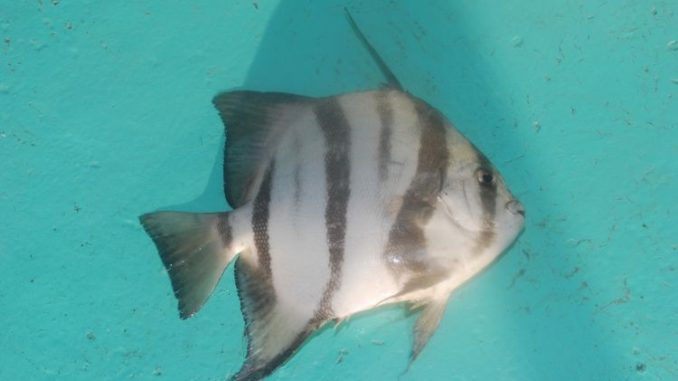
Reports suggest spadefish are tasty, but the author disagrees
They are everywhere.
If you fish offshore at oil and gas platforms, clouds of the convict-striped fish are often visible underwater. Atlantic spadefish are a dominant species in the fish communities that develop around platforms. Research done at LSU found that 97 percent of the fish associated with a studied platform were spadefish.
Fishermen in boats are near the water’s surface and often can’t get a grand view of the number of spadefish around a platform. But observation from the platform’s upper deck reveals hundreds of the animals under and around the structure: Schools commonly hold more than 500 fish.
With their deep body, vaguely resembling the working end of a garden spade and five or six vertical black bars set on a silver body, they are hard to mistake for anything else in saltwater except perhaps a sheepshead.
Most common in offshore waters less than 120 feet deep or so in the northern Gulf, they penetrate much closer to shore in the clearer, less freshwater-influenced waters of Florida and Texas.
Spadefish love structure and will be found over wrecks and reefs, near pilings and buoys, under bridges, in fact anywhere there isn’t just bare bottom — and even there sometimes, but usually not in numbers.
Not a bottom fish, most are found in the upper 65 feet of the water column
Young, smaller fish are found in inshore estuaries, and when less than 1-inch long they are colored entirely black. Swimming at an odd angle, they most closely resemble dead, drifting leaves, providing some camouflage from predators.
Spadefish grow quickly

Every spadefish starts as a fertilized egg spawned near the surface between May and September. Females spawn several times each season and produce an average of 1 million eggs.
They grow quickly the first five years of their life, reaching an average of 17 inches. After that growth slows and growth rates are uneven from fish to fish, making it impossible to estimate age from size.
For example, a 20-inch spadefish can be anywhere from 5 to 14 years old. It is known that they live to be at least 19 years old. Written sources commonly state that they will grow to 20 pounds, but the IGFA world record is a 14-pound, 14-ounce fish taken from Chesapeake Bay. Both sexes mature by one year of age.
Diet is the key to catching them
Spadefish have a wide diet, including sponges, segmented worms, soft corals, tunicates, algae, sea cucumbers, feather stars, sea anemones and planktonic crustaceans. Most famously, they are one of the few creatures that eat jellyfish. In fact, they seem to prefer jellyfish over most other foods.
East Coast anglers, who have fewer numbers and species of desirable fishes than do Gulf Coast anglers, very often use small jelly balls or strips cut from cannonball jellyfish as bait for the banded bandits.
Spadefish can be vigorous feeders and will swarm the post-filleting discarded carcass of a fish to strip every morsel of meat from the frame. But most of the time they are nibblers rather than strikers.
Their small brush-like teeth arranged in bands in a tiny mouth make them experts at stealing bait from a hook. The use of small hooks, or even treble hooks, is important for catching them, and the bait should cover the entire hook.
Presenting the bait by free-lining or under a cork is the best approach. Bottom fishing with lead sinkers is not productive for spadefish.
Lacking jellyfish for bait, the most commonly used spadefish bait on the Atlantic coast is clams cut into strips the size of Band-Aids. Clams are a common bait item sold in East Coast bait shops, but jellyfish aren’t.
Probably the best bait that is easy to find on our coast is shrimp. Veteran spadefish anglers caution that it is important to peel the shrimp tail before burying the hook in it.
But are they any good?
Spadefish are determined fighters and give good sport, much like similarly-shaped sheepshead and freshwater bluegills, using their wide bodies for leverage.
Apparently, spadefish aren’t just for sport either. Reliable reports have them being deadly live baits for catching amberjacks. Besides being relished by big AJs, they are durable and hold up well in live wells, also an important consideration.
Atlantic spadefish are savored as table fare in the Caribbean, (their range extends from Massachusetts south through the Caribbean to southern Brazil) so much so that they may be considered overfished off Columbia and Martinique.
Most North American reference books report the fish as being good to excellent as a food fish. I disagree rather strongly, finding the dingy-colored flesh to be musty in taste. (Remember: I eat and enjoy hardhead catfish and gaspergou.)
Let’s call a spade a spade.


